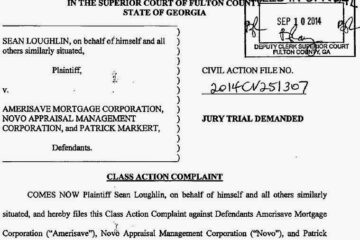On March 31, 2010, Judge Virginia Phillips in the U.S. District Court for the Central District of California dismissed eight homeowner/borrower class actions against home builders and their affiliated mortgage companies. Filed on the same day by the same group of law firms, the eight lawsuits alleged that the builders and mortgage companies had schemed to inflate the price of homes paid by the homeowners at the peak of the housing bubble in 2004-2006. The homeowners alleged that the builders and mortgage companies purportedly concealed that the purchases were risky and likely to lose value — due to, among other things, the risk that many borrowers in the developments would default on their mortgages.
The lawsuits dismissed had named the following defendant builders and their affiliated mortgage companies: Standard Pacific, Lennar Corp., Richmond American Homes Corp., The Ryland Group, Inc., Centex Corp., D.R. Horton, Shea Homes, Inc., and Beazer Homes USA, Inc. All of the cases had been transferred to Judge Phillips because of their similarity and common allegations.
The legal reasoning applied by Judge Phillips in each order dismissing the cases is identical. Here is part of Judge Phillips’ reasoning:
Plaintiffs’ reduced-value injury is not “fairly traceable” to the challenged action of Defendants. First, any loss in value Plaintiffs have suffered has resulted not just from the actions of Defendants, but also from the independent actions of others, e.g., homeowners in Plaintiffs’ neighborhoods who defaulted on their mortgages and third-party mortgage companies that foreclosed on houses in Plaintiffs’ neighborhoods. Plaintiffs’ theory is premised upon a chain of causation that is affected by general economic factors. These general factors can have unpredictable effects, such as collapse of financial institutions, changes in the credit market, and rising unemployment, which by themselves or in combination affect the housing market. In other words, any injuries suffered by Plaintiffs necessarily depend upon a causal chain that includes numerous independent forces and individual decisions of “some third part[ies] not before the court.” Lujan, 504 U.S. at 560-61.
. . .
Similarly, the “housing bubble,” or inflation of housing prices, was a nationwide phenomenon, traceable to variables independent of Defendants’ alleged scheme, such as lax regulatory enforcement, rates of unemployment, credit market developments, and general economic growth. As with Plaintiffs’ reduced-value theory, it cannot be said that the inflated purchase prices Plaintiffs allegedly paid are fairly traceable to Defendants’ alleged “scheme.”
Judge Phillips’ reasoning echoes the growing opinion of many courts that plaintiffs — whether they are borrowers or lenders — cannot blame their economic problems relating to declining home prices and foreclosures on specific defendants like builders, mortgage companies and other parties such as appraisers.
